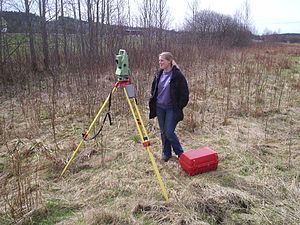| Revision as of 03:41, 30 October 2008 editLMBullen (talk | contribs)1 editm Most total stations today are accurate within 1 arc-second and 1 1000th of a foot← Previous edit | Revision as of 09:14, 21 November 2008 edit undo81.21.81.117 (talk) →ReferencesNext edit → | ||
| Line 29: | Line 29: | ||
| ==References== | ==References== | ||
| * | * | ||
| * | * | ||
Revision as of 09:14, 21 November 2008

A total station is an optical instrument used in modern surveying and archaeology as well as by police, crime scene investigators, private accident reconstructionists and insurance companies to take measurements of scenes. It is a combination of an electronic theodolite (transit), an electronic distance meter (EDM) and software running on an external computer known as a data collector.
With a total station one may determine angles and distances from the instrument to points to be surveyed. With the aid of trigonometry and triangulation, the angles and distances may be used to calculate the coordinates of actual positions (X, Y, and Z or northing, easting and elevation) of surveyed points, or the position of the instrument from known points, in absolute terms.
The data may be downloaded from the theodolite to an external computer and application software will generate a map of the surveyed area.
Some total stations also have a GPS interface which combines these two technologies to make use of the advantages of both (GPS - line of sight not required between measured points; Traditional Total Station - high precision measurement especially in the vertical axis compared with GPS) and reduce the consequences of each technology's disadvantages (GPS - poor accuracy in the vertical axis and lower accuracy without long occupation periods; Total Station - requires line of sight observations and must be set up over a known point or within line of sight of 2 or more known points).
Most modern total station instruments measure angles by means of electro-optical scanning of extremely precise digital bar-codes etched on rotating glass cylinders or discs within the instrument. The best quality total stations are capable of measuring angles down to 0.5 arc-second. Inexpensive "construction grade" total stations can generally measure angles to 5 or 10 arc-seconds.
Measurement of distance is accomplished with a modulated microwave or infrared carrier signal, generated by a small solid-state emitter within the instrument's optical path, and bounced off of the object to be measured. The modulation pattern in the returning signal is read and interpreted by the onboard computer in the total station. The distance is determined by emitting and receiving multiple frequencies, and determining the integer number of wavelengths to the target for each frequency. Most total stations use a purpose-built glass Porro prism as the reflector for the EDM signal, and can measure distances out to a few kilometers, but some instruments are "reflectorless", and can measure distances to any object that is reasonably light in color, out to a few hundred meters. The typical Total Station EDM can measure distances accurate to about 3 millimeters or 1/1000th of a foot.
Some modern total stations are 'robotic' allowing the operator to control the instrument from a distance via remote control. This eliminates the need for an assistant staff member to hold the reflector prism over the point to be measured. The operator holds the reflector him/herself and controls the total station instrument from the observed point.
Vehicular Accident Reconstruction applications
Total stations are used by police, crime scene investigators, private accident reconstructionists and insurance companies to take measurements of scenes. Once they take accurate measurements with a total station they can use software to recreate the accident in a 3D animation.
Mining applications
Total stations are the primary survey instrument used in many mining applications.
Underground mining
As the development drifts in an underground mine are driven, a total station will be used to record the absolute location of the tunnel walls (stope), ceilings (backs), and floors. This data can then be loaded into a CAD program, and compared to the designed layout of the tunnel.
At regular intervals, the survey party will install stations. These are small steel plugs that are drilled into the walls or the back. The plugs are installed in pairs. For wall stations, two plugs are installed in opposite walls, forming a line perpendicular to the drift. For back stations, two plugs are installed in the back, forming a line parallel to the drift.
When the survey crew wants to set up the total station in a drift, they use a set of plugs to locate the total station.